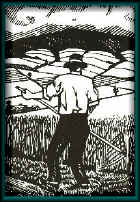Karpathen
Bewoners van de Karpathen noemen zichzelf Lemko's .Er is een uitgebreide site aan hen gewijd, met onder meer dit verhaal over oogst.
THE SUMMER CYCLE: HAYMAKING, HARVEST
Traditionally , haymaking began right after the feast of St. John, called "Yana", (John the Baptist, July 7 th , according to the Gregorian calendar), which preceded the harvest by approximately five to six weeks. According to tradition, the colorful flowers in the spacious meadows were not to be cut down with the scythe before the start of  this holiday.
this holiday.
Lemkos started to sow red clover just before WW I because of its succulent and soft texture, and also because it could be mowed throughout the day, unlike the plain "Lenten" grass, which was mowed only in the morning before the dew evaporated. The grasses and clover were dried out by hanging them from "rohals", which were made from the stripped tops of young pine trees and silver firs.
Every haymaker had, hanging from his belt, a deep wooden or metal vessel called "kuzhivka" ("kushka", "kozivka"), filled with water. Partially submerged into the water was a honing stone, called "osevka", which was periodically used to sharpen the scythe's blade. Some haymakers, just in case, would carry with them a hammer and a small anvil, called "babka", to hammer out a sharper edge on the scythe. Long ago in Lemkivshchyna scythes were forged by the local blacksmiths.
In the Carpathians, as a rule, harvest time began about one to two weeks later than on the plains of "PryKarpatia". During dry and hot weather years, it started in the middle of July, and in cases of cool and wet weather - in early August, to be concluded on "hlavostoky" ( the holiday commemorating the beheading of John the Baptist), which fell on September 12 th . The harvesting of those oats fields, which were located in high mountain clearings, normally took place in late September.
Practically speaking, the harvesting began on the day that the farmer came home with three spikes of rye, wheat, and barley, and placed them in the corner of an icon. [In order to be harvested], the grain had to be dry. The cutting of rye and wheat was done with "hrabky" 1 mounted as an accessory on the scythe, in a manner known as "do stiny" (to the wall). Another person collected what had already been cut down, forming sheaves called "snopy", and binding them together with bands made of straw. Thirty sheaves were placed together to form a "pivkipka". To make a "pivkipka", the first sheaf was folded in half ("lamanyi snope"), and placed on the ground. Across it they stacked up seven sheaves, [on each of four sides], then one more was spread out and placed on top of them to form a roof. The first three sheaves were brought home. Once dried out in the sun and threshed, delicious rolls called "pidpavky" were baked from the new grain. Barley and oats were mowed into "valky" (roller), and when dry, they were raked up and bound into sheaves. Once hauled home, these sheaves were threshed in the fall or winter.
In western Lemkivshchyna, wood shingles were used as roofing material, therefore there was no need to reap the rye straw with sickles and form sheaves for thatching material, called "kichky".
The harvest took place with great respect for every spike of grain, - for crop yields were low and families had many children. If a breadcrumb accidentally fell on the ground, it was picked up with respect and kissed.
1 - "hrabky" – an accessory in shape of a rake, attached to the upper portion of the scythe's handle.
Home Top Wereld



